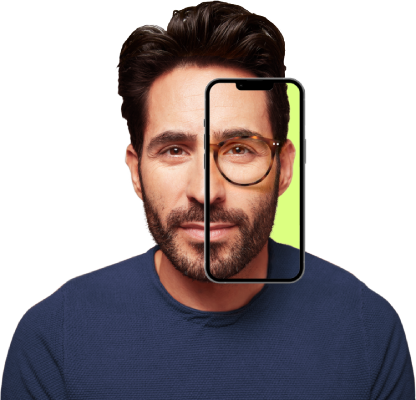
Our new virtual try-on tool lets you try on our latest styles anytime, anywhere!
Everything you need to know to take care of your eyes — for life.

Almost nothing is more annoying than glasses that don’t fit right. They slide down your nose, pinch your temples, or simply look too big or small.
But ill-fitting eyewear is more than just a nuisance. It also may limit your peripheral vision and ability to see clearly.
“If your glasses are too loose, too tight, or crooked, they won’t work their best,” says Stephanie Zielenkievicz, manager of retail operations at America’s Best Contacts & Eyeglasses. “You should never let an improper fit keep you from having the best vision possible, especially when a quick trip to America's Best can fix most issues.”
How do you know if you need an adjustment? Look in the mirror and ask yourself these six questions.
Are you up-to-date on your eye exam? Book an appointment today!
The side pieces that extend from the hinge back over the ears are known as the temples. When they fit properly, the lenses are positioned perfectly in front of your eyes for good vision.
Some sunglasses and drugstore readers may have straight-back temples (sometimes called library temples), which work well if you take your glasses on and off multiple times throughout the day.
But most frames have what’s known as skull temples—meaning they hug your ears for a proper fit. The placement of that little hug is key.
“The bend on skull temples should start just barely past the top of your ear,” says Zielenkievicz. “When the temples fit properly, you shouldn’t feel any pain on or behind the ear. Temples also shouldn’t dig into the sides of your head. If they do, the frames will slide off of your face every time you chew, talk, or move your jaw.”
Frames should fit straight across the face and not press into the front or sides of the head.
“Look for a frame that is at least as wide as the widest part of your face,” suggests Zielenkievicz. “A good eye-care professional will use the three-point touch rule to ensure a good fit.
“The frames should touch the nose, the top of the right ear, and the top of the left ear,” she continues. “If the frame is too narrow, the glasses will constantly slide down your face and need adjustments.”
Worried your glasses are a little crooked? One trick Zielenkievicz uses to gauge the straightness of a frame is to look at the bottom of the eyes.
“Most of us have one eyebrow that’s a little higher than the other,” she says, “but the eyes are usually even. It’s a great point of measurement for glasses.”
If you have red marks on the bridge of your nose after you take off your glasses, it means your glasses are either too tight, bent, or crooked—and your vision will be affected.
“Your optician can make adjustments to fix this problem,” says Zielenkievicz.
Frames made from metal typically have nose pads, while plastic ones do not. “With metal frames, the glasses may slide down your nose when the nose pads are spread out too wide,” she says. “This problem can easily be fixed with a visit to your local America’s Best.”

Our new virtual try-on tool lets you try on our latest styles anytime, anywhere!
If you’re among the many people who use multifocal lenses, such as progressive lenses or bifocals, precision is important so you can see objects clearly at various distances.
“I always like to say that in optics, millimeters are like miles,” says Zielenkievicz, “meaning that being off by a little can throw off the alignment of the glasses and affect where you look through the bifocal or progressive lens.”
Associates at America’s Best can help you select a frame that is deep enough to accommodate a multifocal lens and then preadjust the frames so they feel comfortable. The measurements taken at the time of your eye exam ensure that the bifocal or progressive lenses are in the proper eye position when you pick up your finished eyewear.
Glasses that work well at the office won’t serve you well on the basketball court—or in the saddle of a mountain bike.
If you lead a generally active lifestyle, consider glasses made for people who are on the move.
“Our Rec Specs for kids and adults have more of a wrap-style frame and temples. They also have features like straps and grippier nose pads and temple tips to prevent sliding,” says Zielenkievicz.
All Rec Specs eyewear features impact-resistant lenses made of polycarbonate. These lenses are lighter than regular ones and less prone to breaking.
Whether your fit issue is big or small, help is nearby. For instance, if you take your glasses on and off frequently throughout the day, there’s a good chance they’ll get slightly bent. Your local America's Best can adjust them while you wait.
Likewise, if you’re experiencing noticeable discomfort such as sliding or ear pinching, bring your glasses back to the store.
“Don’t stop wearing your eyeglasses or assume that you need to spend more money on a better-fitting pair,” says Zielenkievicz.
Eye doctors and vision-center associates are trained to properly adjust glasses and have all of the tools necessary to provide a perfect custom fit. Associates can tighten screws, readjust nose pads, and address other bothersome problems.
You might want to drop by your local America’s Best every month or so, even if you aren’t having issues. “Eyeglasses need tune-ups to keep them functioning and fitting properly,” says Zielenkievicz. “Plus, at America’s Best Contacts & Eyeglasses, cleanings and adjustments are always free. Our goal is to help you see the world more clearly.”
Press play for more frame-fitting tips: